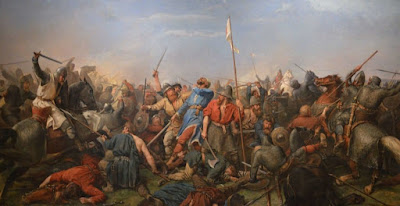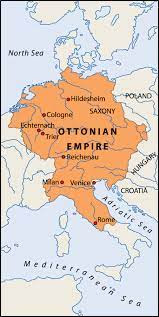There were several Synods of Clovesho recorded in the late 8th and early 9th centuries. The location of Clovesho (meaning "Cliff's-Hoe") has never been satisfactorily identified, but it is generally assumed to be somewhere in the kingdom of Mercia, since the current king of Mercia usually presides.
The Venerable Bede writes that, at the Council of Hertford in 672, Archbishop Theodore of Tarsus declared that he was made Archbishop of Canterbury by the pope, and that there should be a regular synod held on 1 August every year "in the place which is called Clofeshoch." Although it is likely that this schedule was followed, we do not have a record of any of the synods until 716 under King Ethelbald of Mercia, in which the freedom of the churches in Great Britain was confirmed.
The synods resembled the Anglo-Saxon witenagemot, in that it was more than a collection of bishops and abbots, but also included the king and his chief advisors and other high-ranking men of the kingdom.
The next recorded synod took place in 742. It affirmed the decision of 716. King Ethelbald of Mercia presided; his recorded statement is as follows:
I, Ethelbald, king of the Mercians, for the health of my soul and the stability of my kingdom, and out of reverence to the venerable Archbishop Cuthbert, confirm it by the subscription of my own munificent hand, that the liberty, honor, authority, and security of the Church of Christ be contradicted by no man; but that she and all the lands belonging to her be free from all secular services, except military expedition, and the building of a bridge or castle. And we charge that this be irrefragably and immutably observed by all, as the aforesaid king Wihtred ordained for him and his.
I previously mentioned Queen Cynethryth's last recorded mention was at the Synod of Clovesho in 798. It was presided over by King Coenwulf of Mercia and Archbishop Æthelheard. After the death of King Offa, his widow was made abbess at Cookham Abbey. At the synod, Æthelheard produced documents showing that the abbey belonged to Canterbury, and it was not in Mercia's power to make decisions about it. Æthelheard then granted the monastery to Cynethryth, but she had to give up other lands that were in her possession in Kent, amounting to 160 households' worth of property. (The site of Cookham Abbey has only recently been discovered.)
The last recorded Synod of Clovesho was in 824.
The Venerable Bede has been mentioned many times throughout the history of this blog, but has never received his own entry. Time to rectify that.















